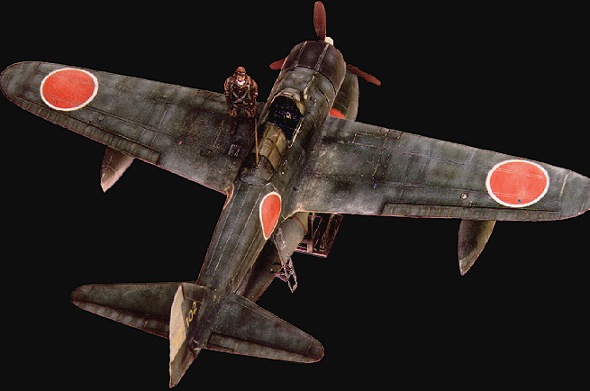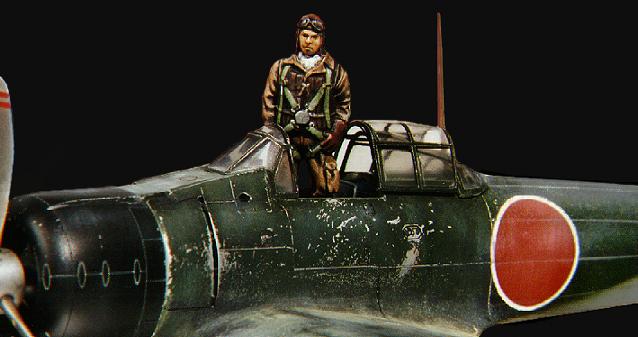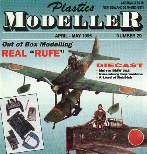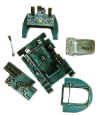|
Tamiya's 1/48 Scale "Rufe" |
Nakajima
A6M2 Type 2 Floatplane Fighter
"Rufe"
by Chris Beaumont
|
Tamiya's 1/48 Scale "Rufe" |
HyperScale regular Chris Beaumont describes his
"Zero on Floats". Two more images in the text and eight more at the bottom of the page:
| I n t r o d u c t i o n |
This aircraft is the seaplane version of the famous Japanese Zero fighter, code named
"Rufe" by the Allies. The Allies used a system of Japanese aircraft
identification code names as simple references instead of a potentially confusing series
of numbers or letters (to use a fictitious example - IJN-459AZ). Male names like Tony,
Frank and Rufe were assigned to all fighter types and reconnaissance seaplanes. Rufe is
actually an old-fashioned American hillbilly name.

The floats are obvious additions. Less noticeable modifications to the Mitsubishi Zero
fighter included a slightly larger rudder and additional measures to waterproof the
airframe. The Rufe was active throughout the Pacific campaign with roles including fighter
- bomber, reconnaissance and escort. Many seaplane bases were built throughout the string
of island outposts set up by the Japanese to facilitate their planned conquest of the
Pacific. 327 Zero floatplane/fighter "Rufes" were said to have been built.
| T h e P h o t o F e a t u r e |
This photo feature compliments a six and a half page black and white article I did for
Australia's "Plastics Modeller" magazine in the April-May 1995, No.29 edition.
The article explains via 27 photos and text the essence of my ongoing approach to seamless
aircraft model making.

The emphasis is on a realistic paint chipping technique I applied to Tamiya's 1/48
Japanese WWII Zero floatplane fighter "Rufe" as described in a step-by-step
painting guide. Also mentioned are the valuable influences of the well-known modeller
Francois Verlinden and the Japanese aviation artist Shigeo Koike, whose exquisite
paintings are featured on many of Hasegawa's model kit box tops.
Final coverage is devoted to highlighting the superb quality of the Japanese aviation
photo reference manuals available from the webshop "Hobbylink Japan" or your
nearest specialist hobby shop.
 Plastics Modeller
magazine No.29 is available from
Plastics Modeller
magazine No.29 is available from
Ropomod Productions Pty. Ltd.
PO Box 30
Tullamarine 3043
Victoria, Australia.
Email- airborne@interdomain.net.au
The editor is of Plastics Modeller is Frank Morgan.
| M o r e P h o t o g r a p h s |
More detail photographs of Chris's Rufe are listed below. Click the thumbnail to see the full sized image. Click the "Back" arrow on your browser to return to this page:
 Exploded view of painted cockpit parts.
Exploded view of painted cockpit parts.
 Note the salt-sprayed appearance of the airframe.This kind of weathering
was hinted at in a couple of my IJN seaplane reference books
Note the salt-sprayed appearance of the airframe.This kind of weathering
was hinted at in a couple of my IJN seaplane reference books
 The boarding ladder would have been removed before takeoff.
The boarding ladder would have been removed before takeoff.
 Note the shiny undersurfaces. The hot tropical sun beat down on the upper
surfaces only, fading the paintwork, leaving the undersides relatively factory fresh.
Aircraft wrecks can still be discovered in jungles of the Pacific these days in the same
condition.
Note the shiny undersurfaces. The hot tropical sun beat down on the upper
surfaces only, fading the paintwork, leaving the undersides relatively factory fresh.
Aircraft wrecks can still be discovered in jungles of the Pacific these days in the same
condition.
 Eye-candy shot of underwing surfaces. Note that the ladder would not be
attached during flight.
Eye-candy shot of underwing surfaces. Note that the ladder would not be
attached during flight.
For More Japanese Aircraft Visit
Mark T. Wlodarczyk's Japanese
Aviation Page and
Dave Pluth's Japanese Aircraft Modelling Page
Model, Description and Photographs Copyright 1998 by Chris
Beaumont
Page Created 12 August 1998
Last updated 26 July 2007
Back to HyperScale Main Page
Back to Feature Articles